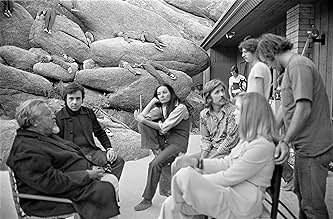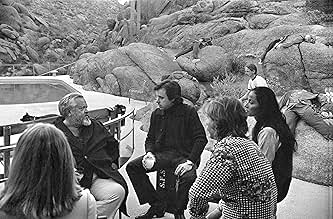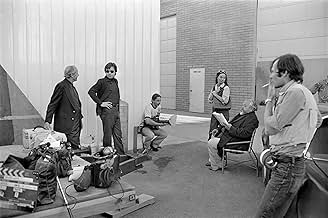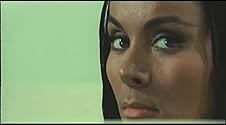VALUTAZIONE IMDb
6,7/10
8349
LA TUA VALUTAZIONE
Un regista di Hollywood emerge dal semi-esilio con l'intenzione di completare il lavoro su un film innovativo.Un regista di Hollywood emerge dal semi-esilio con l'intenzione di completare il lavoro su un film innovativo.Un regista di Hollywood emerge dal semi-esilio con l'intenzione di completare il lavoro su un film innovativo.
- Premi
- 9 vittorie e 8 candidature totali
Robert Random
- John Dale
- (as Bob Random)
Recensioni in evidenza
Other reviews have shed light on the challenges and controversy surrounding the creation of this film, so I will not cover that. The initial scenes are haphazard, but after a short while, the plot adopts a firmer grasp. Some scenes were shot in b/w, and other in color, and the mix of the various film stocks does work, for the most part. Shrewd, biting humor infuse the entire film, which skewers the Hollywood studio system and offers glimpses of hangers-on, while highlighting the sordid nature of fame.
Wonderful cast, with standout performances from Huston and Foster. Some of the the dialogue appeared improvised, and the energy was highly-charged. The upbeat jazz score by Michel Legrand was terrific. Overall, I enjoyed this wild ride. Even so, I wonder what would have happened if Welles would have had the funds to personally helm this film into full fruition? Did he genuinely intend for this film to be finished by someone else? What would have happened if it had been retained as a lengthy, experimental journey?
Wonderful cast, with standout performances from Huston and Foster. Some of the the dialogue appeared improvised, and the energy was highly-charged. The upbeat jazz score by Michel Legrand was terrific. Overall, I enjoyed this wild ride. Even so, I wonder what would have happened if Welles would have had the funds to personally helm this film into full fruition? Did he genuinely intend for this film to be finished by someone else? What would have happened if it had been retained as a lengthy, experimental journey?
I had the privilege of seeing this at the New York Film Festival. A sense of awe descended upon the audience as soon as the opening credits began. The fact that this film was finally completed and released is a triumph in and of itself.
Orson Welles' final film is chaotic and unwieldy, but also very haunting and melancholy. The soundtrack is amazing. There is frankly a sliver of a plot. An aging director attempts to make a comeback as Hollywood has drifted away from his era as he throws a big birthday party in which journalists, critics, admirers and some industry professionals join to celebrate. It soon becomes apparent that reporters are there to ascertain information about more than his work. His new film that is in the works is shown. We get to see an unfinished film within a film that is titled "The Other Side of the Wind", one that is sexually explicit.
The late John Huston portrays Jake Hannaford, the director whose approach to filmmaking has earned him a great following and his relationships with the actors he works with makes him a lightning rod of controversy. Huston's sepulchral voice and domineering presence make him flawless in the role as Hannaford. Peter Bogdanovich is well utilized as a younger, successful director whom Hannaford has taken under his wing but whom now Hannaford consults on how to better reach audiences of the new era.
This film is not flawless. The experience of seeing this at long last outweighs its drawbacks. There are some parts of this film that drag a bit. But there are also many, many scenes that are just astounding and I'm so happy they were finally brought to the big screen. Although this film is inconsistent in its narrative thrust, it returns very quickly to its busy, slightly manic state. I don't know if Welles deliberately left this unfinished. What I can say is that the editing is superb and provides us with a film that is a lasting testament to Welles and his legacy as a filmmaker. Highly recommended.
Orson Welles' final film is chaotic and unwieldy, but also very haunting and melancholy. The soundtrack is amazing. There is frankly a sliver of a plot. An aging director attempts to make a comeback as Hollywood has drifted away from his era as he throws a big birthday party in which journalists, critics, admirers and some industry professionals join to celebrate. It soon becomes apparent that reporters are there to ascertain information about more than his work. His new film that is in the works is shown. We get to see an unfinished film within a film that is titled "The Other Side of the Wind", one that is sexually explicit.
The late John Huston portrays Jake Hannaford, the director whose approach to filmmaking has earned him a great following and his relationships with the actors he works with makes him a lightning rod of controversy. Huston's sepulchral voice and domineering presence make him flawless in the role as Hannaford. Peter Bogdanovich is well utilized as a younger, successful director whom Hannaford has taken under his wing but whom now Hannaford consults on how to better reach audiences of the new era.
This film is not flawless. The experience of seeing this at long last outweighs its drawbacks. There are some parts of this film that drag a bit. But there are also many, many scenes that are just astounding and I'm so happy they were finally brought to the big screen. Although this film is inconsistent in its narrative thrust, it returns very quickly to its busy, slightly manic state. I don't know if Welles deliberately left this unfinished. What I can say is that the editing is superb and provides us with a film that is a lasting testament to Welles and his legacy as a filmmaker. Highly recommended.
Years ago I saw a documentary that included a scene from a never-released Orson Welles film, The Other Side of the Wind. It was remarkably modern, a kaleidoscopic, eccentric work that was surprising for someone Welles age.
It wasn't until 2020 that I learned the film had actually been pulled together and released.
The cinema-verite style is explained as the result of pulling together footage from various documentarians and journalists video. The film begins with various hangers on of a famous director traveling to his party while elsewhere an investor is watching footage from his current, unfinished film.
This is actually the weakest part of the movie. The individual scenes are confusing and the way they are intercut with the film-within-a-film just add to the confusion. Apparently Welles had rough-cut about half the movie by the time he died, and my suspicion is this first part was not part of that rough cut, since it's weaker. Just a guess.
The film-within-a-film seems to be a parody of trippy, avant-garde, 60s filmmaking. I take it as Welles' portrayal of an old director past his glory days trying to create something hip.
The movie gets its footing when the director's party starts. There is a lot of striking B&W footage cut in and John Huston as the director is a powerful force. The party is to screen his movie, such as it is, and while it is essentially a plotless bit of nonsense with tons of gratuitous nudity, it does have some striking imagery, such as a scene set in slatted shadows and another involving a beaded necklace.
The surrounding film doesn't have much story. It's mainly about the director charming or dueling with various characters who want something from him. Things are hinted but rarely spelled out.
Welles was a genius, so even his worst movies, like Mr. Arkadin, are splashed with brilliance. Other Side of the Wind has a remarkable style and is generally fascinating, but it's not always satisfying and the film-within-a-film takes up more time than it probably should have.
If you're a fan of Orson Welles, or just a fan of cinema, this is a must-see. Yes, the movie would have been more impressive if it had been released in the early 70s, when it was filmed, but even today in a world full of found-footage movies this is still remarkable.
It wasn't until 2020 that I learned the film had actually been pulled together and released.
The cinema-verite style is explained as the result of pulling together footage from various documentarians and journalists video. The film begins with various hangers on of a famous director traveling to his party while elsewhere an investor is watching footage from his current, unfinished film.
This is actually the weakest part of the movie. The individual scenes are confusing and the way they are intercut with the film-within-a-film just add to the confusion. Apparently Welles had rough-cut about half the movie by the time he died, and my suspicion is this first part was not part of that rough cut, since it's weaker. Just a guess.
The film-within-a-film seems to be a parody of trippy, avant-garde, 60s filmmaking. I take it as Welles' portrayal of an old director past his glory days trying to create something hip.
The movie gets its footing when the director's party starts. There is a lot of striking B&W footage cut in and John Huston as the director is a powerful force. The party is to screen his movie, such as it is, and while it is essentially a plotless bit of nonsense with tons of gratuitous nudity, it does have some striking imagery, such as a scene set in slatted shadows and another involving a beaded necklace.
The surrounding film doesn't have much story. It's mainly about the director charming or dueling with various characters who want something from him. Things are hinted but rarely spelled out.
Welles was a genius, so even his worst movies, like Mr. Arkadin, are splashed with brilliance. Other Side of the Wind has a remarkable style and is generally fascinating, but it's not always satisfying and the film-within-a-film takes up more time than it probably should have.
If you're a fan of Orson Welles, or just a fan of cinema, this is a must-see. Yes, the movie would have been more impressive if it had been released in the early 70s, when it was filmed, but even today in a world full of found-footage movies this is still remarkable.
The Other Side of the Wind is not a perfect film, but perhaps the perfect film to punctuate Orson Welles' incredible and monolithic career, and certainly the most appropriate film to leave unfinished due to difficulty in production. Or perhaps it is the genius of Welles to have left the film unfinished on purpose?
The film focuses on "the man, the myth, the legend" type J.J. Hannaford, who is making his comeback film after a long hiatus of being out of touch with the modern movie realm. He celebrates his birthday by having a documentary team, friends, associates, and others join him for a showing of his new film "The Other Side of the Wind" starring his striking new lead actor Johnny Dale and lead actress (who is nameless according to the bill). What ensues is a chaotic, fast-paced bombardment of quick edits, snappy dialog, a movin' sound track, and fantastic camera-work sandwiched between the hypnotic, near-legato, orchestral moments of Hannaford's film "The Other Side of the Wind".
It took me about 25 min to get used to the faced-paced, almost bravado tone of the editing because I wanted more time to saturate the emotions and facial expressions of the characters. This is why I think the sections that show Hannaford's film stick out even more though; finally having time to "breath" (if you will) versus the zaniness of being in the business (reality). It even feels at times that Hannaford himself is drowning and just wants to breath. Even still, does Welles conduct an amazing performance from the grizzled-veteran John Huston, who nails the semi-pretentious over-indulgent Hannaford to a tee.
The highlights of Welles' last picture surely come from the technical aspects of the production, the anticipation born from it's long-troubled existence of coming to fruition, and the lead performance from Huston. I must say there are a handful of poignant, enigmatic scenes that truly hypnotize such as "The Other Side of the Wind"s rather incredible car scene, which for me was the true top moment of this feature. The camerawork changing from black and white to deep color is used to great effect as well.
I suppose we will never know if what we have today is truly Welles' vision fully intact, or just a shadow of what is was supposed to be. The Other Side of the Wind is definitely for any fans of Orson Welles and for those who enjoy seeing filmmaking done years ahead of its time. I feel like I must say that this film isn't getting praise from me simply because Welles' name is slapped on it, but good because there are a bunch of things to appreciate.
The film focuses on "the man, the myth, the legend" type J.J. Hannaford, who is making his comeback film after a long hiatus of being out of touch with the modern movie realm. He celebrates his birthday by having a documentary team, friends, associates, and others join him for a showing of his new film "The Other Side of the Wind" starring his striking new lead actor Johnny Dale and lead actress (who is nameless according to the bill). What ensues is a chaotic, fast-paced bombardment of quick edits, snappy dialog, a movin' sound track, and fantastic camera-work sandwiched between the hypnotic, near-legato, orchestral moments of Hannaford's film "The Other Side of the Wind".
It took me about 25 min to get used to the faced-paced, almost bravado tone of the editing because I wanted more time to saturate the emotions and facial expressions of the characters. This is why I think the sections that show Hannaford's film stick out even more though; finally having time to "breath" (if you will) versus the zaniness of being in the business (reality). It even feels at times that Hannaford himself is drowning and just wants to breath. Even still, does Welles conduct an amazing performance from the grizzled-veteran John Huston, who nails the semi-pretentious over-indulgent Hannaford to a tee.
The highlights of Welles' last picture surely come from the technical aspects of the production, the anticipation born from it's long-troubled existence of coming to fruition, and the lead performance from Huston. I must say there are a handful of poignant, enigmatic scenes that truly hypnotize such as "The Other Side of the Wind"s rather incredible car scene, which for me was the true top moment of this feature. The camerawork changing from black and white to deep color is used to great effect as well.
I suppose we will never know if what we have today is truly Welles' vision fully intact, or just a shadow of what is was supposed to be. The Other Side of the Wind is definitely for any fans of Orson Welles and for those who enjoy seeing filmmaking done years ahead of its time. I feel like I must say that this film isn't getting praise from me simply because Welles' name is slapped on it, but good because there are a bunch of things to appreciate.
Some films are hard to judge, especially something like this, that may be very close to what Welles intended, but never finished and never really seemed to be really satisfied with (see also the documentary about Welles from 2018, which is really good). Now there are things in here that may seem redundant to some or annoying. Or even pretentious to some extend. If that rings true to you or not, it doesn't mean you are right or wrong, one way or the other. It just means you have feeling and maybe knowledge and that's why you lean to a particular way or side.
Having written all that, I am surprised by the amount of nudity that made it into the film. I'm also surprised about the film depicting scenes being shot "in real time" with off commentaries by the director, with different cameras, cuts and all that. Now obviously we are taking creative liberties here and it's supposed to be heightened. It's to prove a point or even points. So in a way there is more to the film than meets the eye. You have to approach this movie with a certain mindset.
If you do that, you may be able to see more than some others. But if you don't you'll probably be bored. Whatever your stance on this is and it will be dividing, you cannot call this an easy movie to watch. Some probably will watch it multiple times and cherish it's commentary and behind the scenes insights as much as its psychology. Others will just sneer at the mention of the title. In a way I'd say that would make Welles happy after all ...
Having written all that, I am surprised by the amount of nudity that made it into the film. I'm also surprised about the film depicting scenes being shot "in real time" with off commentaries by the director, with different cameras, cuts and all that. Now obviously we are taking creative liberties here and it's supposed to be heightened. It's to prove a point or even points. So in a way there is more to the film than meets the eye. You have to approach this movie with a certain mindset.
If you do that, you may be able to see more than some others. But if you don't you'll probably be bored. Whatever your stance on this is and it will be dividing, you cannot call this an easy movie to watch. Some probably will watch it multiple times and cherish it's commentary and behind the scenes insights as much as its psychology. Others will just sneer at the mention of the title. In a way I'd say that would make Welles happy after all ...
Lo sapevi?
- QuizThe movie was filmed between 1970 and 1976, with editing continuing into the 1980s. When he died in October 1985, Welles left behind nearly 100 hours of footage and a work print consisting of assemblies and a few edited scenes.
- BlooperIn one confrontational scene, Brooks Otterlake, who Gregory Sierra's character, Jack Simon, refers to as, "Kid", is simultaneously Peter Bogdanovich and Rich Little. This is small overlap is because Rich Little was originally cast as the black turtleneck wearing, voice imitating director, Brooks Otterlake. However Bogdanovich replaced him, and Little's part was reduced to that of a Party Guest.
- Citazioni
[last lines]
Jake Hannaford: Who knows, maybe you can stare too hard at something, huh? Drain out the virtue, suck out the living juice. You shoot the great places and the pretty people... All those girls and boys. Shoot 'em dead.
- Curiosità sui creditiAfter the end credits, Hannaford's voice is heard saying "Cut"
- ConnessioniFeatured in AFI Life Achievement Award: A Tribute to Orson Welles (1975)
- Colonne sonoreLes Délinquants
Written and performed by Michel Legrand
Published by WB Music Corp. o/b/o Productions,
Michel Legrand + Editions Royalty
Courtesy of Decca Records France
Under license from Universal Music Enterprises
I più visti
Accedi per valutare e creare un elenco di titoli salvati per ottenere consigli personalizzati
- How long is The Other Side of the Wind?Powered by Alexa
Dettagli
- Data di uscita
- Paesi di origine
- Sito ufficiale
- Lingue
- Celebre anche come
- The Other Side of the Wind
- Luoghi delle riprese
- Aziende produttrici
- Vedi altri crediti dell’azienda su IMDbPro
- Tempo di esecuzione2 ore 2 minuti
- Colore
- Mix di suoni
Contribuisci a questa pagina
Suggerisci una modifica o aggiungi i contenuti mancanti





































